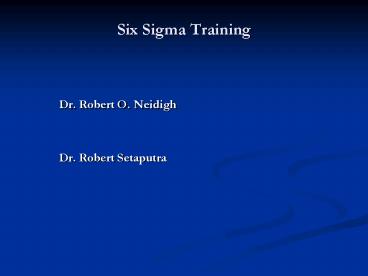Six Sigma Training - PowerPoint PPT Presentation
Title:
Six Sigma Training
Description:
Six Sigma Training. Dr. Robert O. Neidigh. Dr. Robert Setaputra ... Sigma ... in six sigma is defined as 3.4 ppm! Analyze Step and Six Sigma ... – PowerPoint PPT presentation
Number of Views:108
Avg rating:3.0/5.0
Title: Six Sigma Training
1
Six Sigma Training
- Dr. Robert O. Neidigh
- Dr. Robert Setaputra
2
Process Out of Control
- Point above UCL or below LCL
- 9 consecutive points on one side of center line,
indicates that process mean has shifted - 6 consecutive points increasing or decreasing,
signals a drift in the process mean - 14 consecutive points alternating up and down,
indicates that two systematically alternating
causes are producing different results - 2 out of 3 consecutive points in Zone A or
beyond, early warning of a process shift,
probability of a Type II Error is approximately
2
3
Process Out of Control cont.
- 4 out of 5 consecutive points in Zone B or
beyond, early warning of a process shift,
probability of a Type II Error is approximately
2 - 15 points in a row in Zone C, indicates less
variability than expected, would like to
determine why - 8 consecutive points in Zones B and A or beyond
on either side of the center line, indicates that
different samples are affected by different
factors resulting in a bimodal distribution of
means
4
Causes of Variation
- Common causes causes of variation that are
inherent in the process, responsibility of
management to change the policies and procedures
that define the process, qualitative tools can be
used to help make changes - Assignable causes causes of variation that are
not inherent in the process, responsibility of
the workers and engineers, control charts are
used extensively
5
Process Capability
- Compares the output of an in-control process to
the specification limits by using capability
indices. - Capability indices are ratios between the spread
of the specification limits and the spread of the
process. - Two capability indices
- Cp
- Cpk
6
Cp
- s known
- Cp (USL LSL)/6s
- s unknown
- Cp (USL LSL)/6S
- The higher, the better!
7
Cp
- USL LSL 6s 8s 10s 12s
- Cp 1.00 1.33 1.66 2.00
- Rejects 0.27 64 ppm .6 ppm 2 ppb
- of spec 100 75 60 50
- Assumes mean is centered in specification limits
8
Cpk
- s known
- Cpk min(USL µ)/3s, (µ LSL)/3s
- s unknown
- Cpk min(USL x-bar)/3S, (x-bar LSL)/3S
- The higher, the better!
9
Qualitative Tools
- Cause and Effect Diagram
- Root Cause Analysis 5 Whys
- Failure Mode and Effects Analysis (FMEA)
10
Cause and Effect Diagram
- Used to organize possible sources of variation in
a CTQ - Fishbone diagram
- Page 151
11
Root Cause Analysis
- Ask what causes the problem
- Write down the answer
- If answer does not identify root cause of the
problem, ask why again - Continue until root cause is identified
- 5 Whys is rule of thumb
12
FMEA
- Considers at causes of failures
- Redesign process to eliminate or minimize future
failures - Assigns risk priority number (RPN) based upon
scales of severity, likelihood of occurrence, and
detection - The higher the RPN, the more important the
failure - After redesign, reassign RPN
- Pages 156 - 160
13
What does Six Sigma Represent?
- Voice of the Process (VoP) should take up no more
than half of the Voice of the Customer (VoC). - Plus or minus 3s should take up no more than half
of the specification limits. Thus, the
specification limits should be no less than plus
or minus 6s. If the mean is centered, than the
defect rate is 2 ppb!!! - It is common for process variation to increase
periodically and then drop back to the normal
level. Studies have shown that this increase is
equivalent to a 1.5s shift in the mean. When this
occurs, the defect rate is still only 3.4 ppm.
This is why quality in six sigma is defined as
3.4 ppm!
14
Analyze Step and Six Sigma
- The tools provided in this section are used to
decrease process variation, properly center the
process mean, and to eliminate waste or
unnecessary steps. - Also, by listening to the VoC the process
specifications can be properly determined. - Control charts are not just tools to control a
process, but more importantly are used to
decrease variation through the detection and
elimination of assignable causes of variation.



















![Six Sigma Green Belt |[MindCypress]International Certification Training PowerPoint PPT Presentation](https://s3.amazonaws.com/images.powershow.com/9309830.th0.jpg?_=20190731103)











